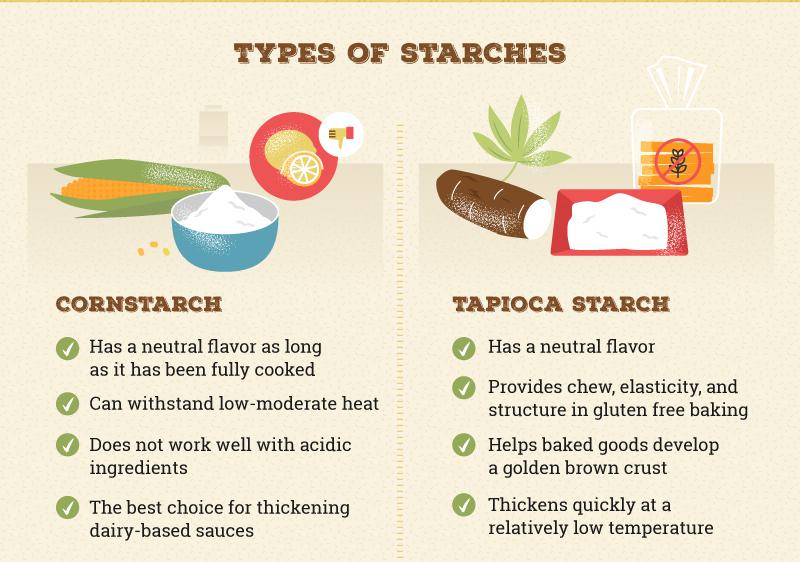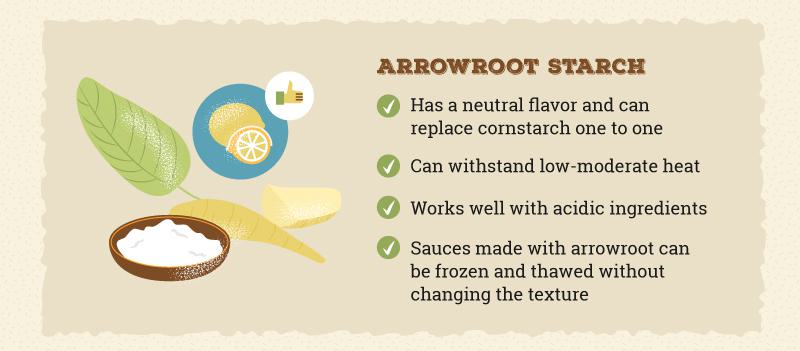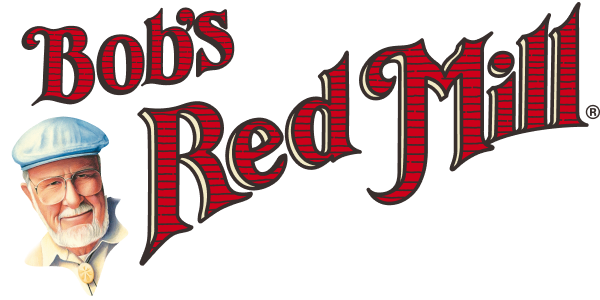 Starches are incredibly versatile ingredients to have on hand and are particularly useful both as thickeners and in gluten free baking. Here at Bobs Red Mill we carry different types of starches that cater to different food allergies or diets. Cornstarch is the most widely recognized, but for those looking for a corn-alternate we also have Arrowroot Starch, Tapioca Starch, Potato Starch, and Sweet White Rice Flour which though technically not a starch can be used like one in practice.
Starches are incredibly versatile ingredients to have on hand and are particularly useful both as thickeners and in gluten free baking. Here at Bobs Red Mill we carry different types of starches that cater to different food allergies or diets. Cornstarch is the most widely recognized, but for those looking for a corn-alternate we also have Arrowroot Starch, Tapioca Starch, Potato Starch, and Sweet White Rice Flour which though technically not a starch can be used like one in practice.
But what do starches do?
Generally, when starches are added to liquids they absorb water. As theyre heated, the tiny starch granules swell and then burst, emptying more starch molecules into the liquid causing it to thicken. In gluten free baking, the starch molecules help to bind ingredients together, adding moisture and texture to your gluten free baked goods.
Starches and starchy flours (like Sweet White Rice) are usually used in a smaller ratio than heavier flours in gluten free flour blends. This is because adding too much starch granules can cause your baked goods to be gummy - its important to find a good balance. Starches can also be used as a coating for frying as an alternative to wheat flour.

How do I use a starch to thicken my recipe?
To thicken liquids with starches, you will first need to make a slurry which is similar to a roux, but is added at the end of the cooking process rather than the beginning. Adding raw starch directly to liquids will cause the starch to form clumps - not what were going for.
To make a slurry, combine your starch with an equal amount of cool or tepid water and stir to dissolve into a pourable liquid. Slowly pour the slurry into the main liquid to be thickened (this liquid should be warm to start) and stir or whisk constantly over even heat until the liquid has thickened. Some starches cannot tolerate boiling or cooking for long periods of time, or may not work with acidic ingredients, so be aware of the properties of the starch that you are working with - see below!


Cornstarch
Cornstarch is made from the starchy endosperm of corn and has long been used as a thickener for sauces, custards, and gravies. Bobs Red Mill Cornstarch is made from Non-GMO corn. If your recipe calls for wheat flour as a thickener, you can use half the amount of corn starch as a substitution - its a pretty strong thickener. In gluten free baking, Corn starch can be used to add softness to gluten free baked goods like pancakes and muffins and is great when used in combination with Tapioca Starch.
- Has a neutral flavor but can leave a chalky, starchy flavor if not cooked long enough
- Should be mixed into a slurry before thickening liquid
- Can withstand low-moderate heat but will break down and lose its ability to bind in long, temperature cooking or freezing
- Does not work well with acidic ingredients
- Adds an opaque quality to sauces
Try it in this recipe for
Boston Cream Pie Cookies!
Tapioca Starch
Tapioca Starch, also called Tapioca Flour, is made from the starchy tuberous root of the cassava plant. To make tapioca flour from cassava, the tubers are first peeled to remove the stem, excess soil, and skin. The peeled cassava is then thoroughly washed, chopped, and finely grated into a pulp. Water and the cassava pulp are then put into a hydrocyclone where they are spun to extract the starch and separate the fibrous pulp. The resulting starch liquid is then dried into our tapioca flour.
- Has a neutral flavor and provides chew, elasticity, and structure in gluten free baking
- Will help baked goods develop a golden brown crust
- Can cause baked goods to be a big tough/dry, so ensure your recipe has enough liquid to balance
- Should be mixed into a slurry before thickening liquid
- Adds a shiny gloss to sauces
- Can replace Cornstarch in a 3:4 ratio (3 tbsp Cornstarch = 4 tbsp Tapioca Starch)

Try it in this recipe for
Honey Blackberry Pie!
Arrowroot Starch
Arrowroot Starch, also called Arrowroot Flour, is derived from the rhizomes of an herbaceous perennial found in tropical climates. The starch is extracted from the rhizomes that are washed, pulped, pressed and dried, then ground into a fine, white, powdery starch. It can be used as the starch component in gluten free flour blends and works very well as a thickener.
- Has a neutral flavor and can replace cornstarch one for one to thicken sauces, stews, and soups
- Should be mixed into a slurry before thickening liquid
- Can withstand low-moderate heat but will break down and lose its ability to bind in long, high temperature cooking
- Works well with acidic ingredients (like in your lemon curd!) but not in milk-based cream sauces as it may cause curdling
- Adds a shiny gloss to sauces
- Can replace Cornstarch in a 1:1 ratio

Try it in this recipe for
Roasted Blueberry Ice Cream!
Potato Starch
Potato Starch is made from a variety of potato that has a very high starch content. After grinding the potatoes and separating the water from the potato pulp, the starch is extracted out of the potato pulp with tap water. It is then dried to a powder. It is naturally white in color and not bleached in any way. Potato Starch is not the same as Potato Flour - Potato Flour is made from dried and ground Russet Potatoes and has a very strong potato flavor.
- Has a neutral flavor and provides a balance of structure and tenderness in gluten free baked goods
- Can replace 1 Tbsp cornstarch using 1 3/4 Tbsp Potato Starch
- Should be mixed into a slurry before thickening liquid
- Can withstand low-moderate heat but will break down eventually in boiling liquid
- Cannot be used where your recipe calls for Potato Flour
Try it in this recipe for
Orange Almond Flour Cake!
Sweet White Rice Flour
Though not a pure starch, Sweet White Rice Flour can be used in a similar manner in baking and cooking. It is made from a very starchy white rice also called glutinous rice although it does not contain gluten. Sweet White Rice Flour isnt actually sweet either, but it is much starchier than White Rice Flour - talk about misnomer! Because of its starchiness, Sweet White Rice Flour is an effective binder and is often used in a similar manner to starches.
- Has a neutral rice-like flavor
- Can replace wheat flour in a 1:1 ratio for thickening
- Cannot be used as a replacement for White Rice Flour
- Holds up well to high heat
- Acts as a strong binder in gluten free baked goods

Try it in this recipe for
Marbled Red Bean Cake!
Whew, thats a lot of information to take in. Use this as a guide when youre looking to replace Cornstarch in a recipe or just looking to experiment! Generally these starches all perform the same task but each has their own unique properties.




 Starches are incredibly versatile ingredients to have on hand and are particularly useful both as thickeners and in gluten free baking. Here at Bobs Red Mill we carry different types of starches that cater to different food allergies or diets. Cornstarch is the most widely recognized, but for those looking for a corn-alternate we also have Arrowroot Starch, Tapioca Starch, Potato Starch, and Sweet White Rice Flour which though technically not a starch can be used like one in practice.
Starches are incredibly versatile ingredients to have on hand and are particularly useful both as thickeners and in gluten free baking. Here at Bobs Red Mill we carry different types of starches that cater to different food allergies or diets. Cornstarch is the most widely recognized, but for those looking for a corn-alternate we also have Arrowroot Starch, Tapioca Starch, Potato Starch, and Sweet White Rice Flour which though technically not a starch can be used like one in practice.



 Try it in this recipe for Honey Blackberry Pie!
Try it in this recipe for Honey Blackberry Pie!
 Try it in this recipe for Roasted Blueberry Ice Cream!
Try it in this recipe for Roasted Blueberry Ice Cream!
 Try it in this recipe for Marbled Red Bean Cake!
Whew, thats a lot of information to take in. Use this as a guide when youre looking to replace Cornstarch in a recipe or just looking to experiment! Generally these starches all perform the same task but each has their own unique properties.
Try it in this recipe for Marbled Red Bean Cake!
Whew, thats a lot of information to take in. Use this as a guide when youre looking to replace Cornstarch in a recipe or just looking to experiment! Generally these starches all perform the same task but each has their own unique properties.
